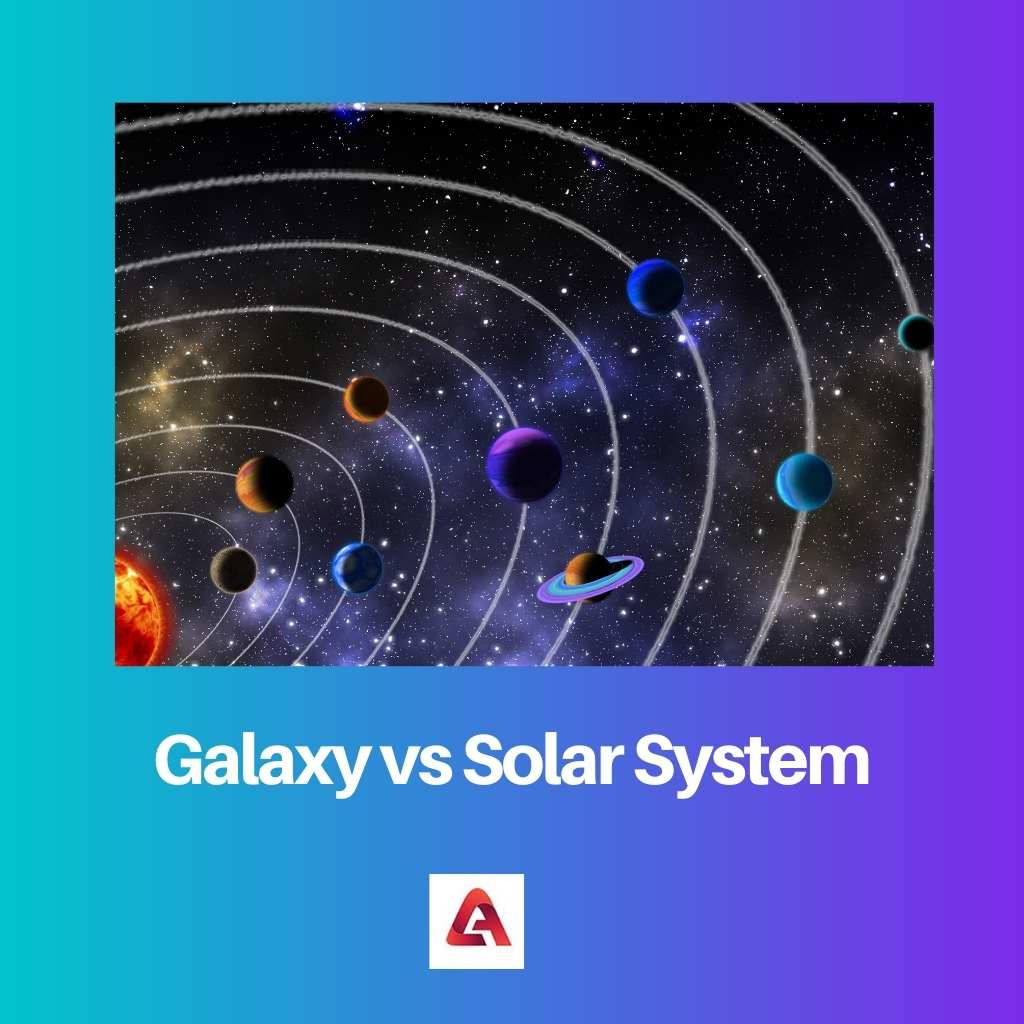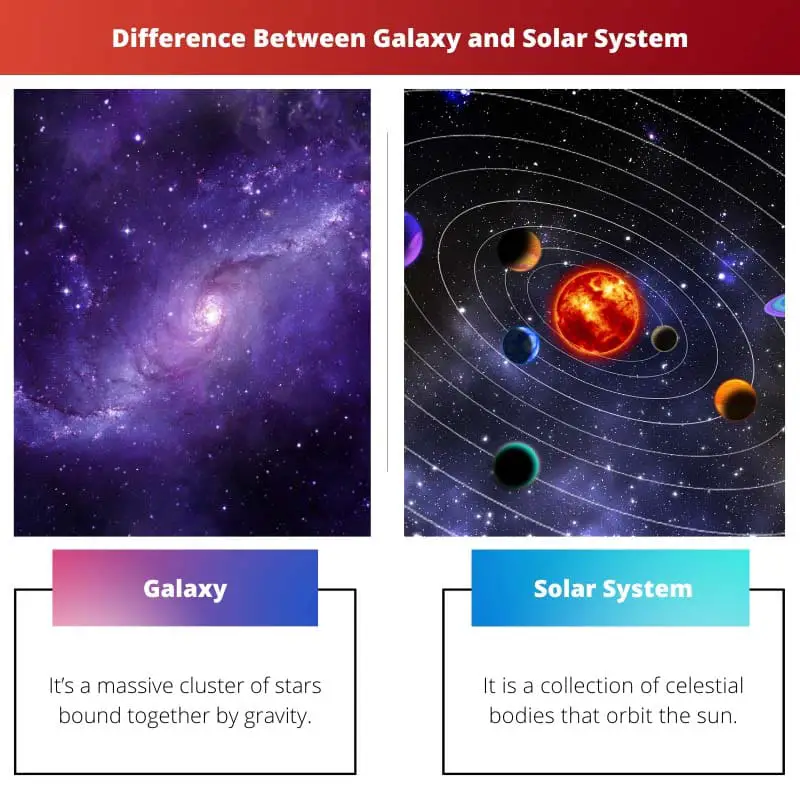Even though the terms solar system and galaxy are separate, they are frequently used interchangeably. A single galaxy can contain several solar systems, while the reverse is not true.
A solar system is a system in which the Sun is the central component. Everything that revolves around the sun, including the planets that orbit it, makes up the solar system.
Key Takeaways
- A galaxy is a vast collection of stars, gas, dust, and dark matter bound together by gravity, while a solar system consists of a star and its orbiting planets, moons, and other celestial objects.
- Galaxies contain multiple solar systems, with the Milky Way galaxy housing our solar system among billions of others.
- Solar systems are smaller in scale and focused on the relationships between a central star and its orbiting objects. In contrast, galaxies encompass vast cosmic structures and interactions between numerous celestial bodies.
Galaxy vs Solar System
A galaxy is a massive system of stars, dust, gas, and other celestial bodies, bound together by gravity. A solar system is used to describe a small planetary system consisting of the Sun, eight planets and their moons, dwarf planets, asteroids, comets, etc. all orbiting around the Sun.

A galaxy is a massive, gravitationally linked structure composed of stars, stellar remains, an interstellar medium of dust and gas, and dark matter.
The word galaxy is derived from the Greek term ‘galaxias,’ which means “milky.” It’s a reference to our galaxy, the Milky Way.
The Solar System consists of the Sun and its eight planets. Several smaller planets, satellites, and other things circle the sun as well.
The Solar System was established 4.6 billion years ago when a huge molecular cloud lost its gravitational attraction.
The Sun holds the bulk of the system’s cloud mass, while Jupiter holds the remainder. Outer planets are the four principal planets: Mercury, Venus, Earth, and Mars.
Comparison Table
| Parameters of Comparison | Galaxy | Solar System |
|---|---|---|
| Definition | It’s a massive cluster of stars bound together by gravity. | It is a collection of celestial bodies that orbit the sun. |
| Classification | According to their shape and size | No classification |
| Centre | Blackhole | Sun |
| Length | Larger | Smaller |
| Dark Matter | Yes | No |
| Stars | 100 million to over a trillion stars. | One star around which planets orbit, |
What is the Galaxy?
A galaxy is a collection of solar systems and other celestial bodies. Like solar systems, galaxies are kept together by gravity. The solar systems in galaxies are separated by enormous swaths of mainly space.
Galaxies are said to have been classified based on their apparent form. An elliptical galaxy, which has an elliptical light pattern, is a frequent example. Spiral galaxies have dusty, bending arms and are disk-shaped.
The Milky Way is the galaxy that houses the Earth and its solar system. More than 200 billion stars are predicted to exist in our galaxy.
Solar systems orbit their galaxies in the same way as planets orbit their suns. The orbit of the Earth’s solar system takes around 200 to 250 million years to complete.
Galaxies consist of dark matter, they are a form of stuff that has been discovered to have gravitational effects. Dark matter is invisible since it does not produce any radiation.
It’s thought that active galactic nuclei can be discovered in the center of some galaxies. At least one such object is known to exist in the Milky Way galaxy.
Irregular galaxies are those that have irregular or odd forms, and they form because of the gravitational attraction of nearby galaxies disrupting them.
Such interactions between adjacent galaxies can lead to a merger and, in some cases, to greatly enhanced star creation, resulting in starburst galaxies. The term “irregular galaxies” refers to smaller galaxies.

What is Solar System?
The Solar System is situated within one of the Milky Way’s outer arms, which includes around 200 billion stars. A galaxy may contain many solar systems, but a solar system cannot contain a galaxy.
A solar system is made up of a star, such as a sun, and the objects that are influenced by its gravitational pull. Planets, moons, asteroids, comets, and meteoroids are among these objects.
Even though solar systems are smaller than the cosmos or a galaxy, the immensity of even the tiniest solar system is impossible for the human mind to grasp.
If the sun were the size of a tennis ball, the Earth would be the size of a grain of sand at a distance of around 8 meters (26 feet).
Several areas of the Solar System are occupied by smaller objects. There are perhaps a dozen more thousand items within these populations that may have been shaped by their gravity.
Dwarf planets are the name given to such objects. The asteroid Ceres, as well as trans-Neptunian objects like Pluto, Eris, and Haumea, have been recognized as dwarf planets.
Comets, centaurs, and interplanetary dust are among the numerous small-body groups that freely migrate across areas. Natural satellites circle six of the planets, as well as many of the smaller bodies.
They’re commonly referred to as ‘moons,’ after the Earth’s Moon. Dust rings and other tiny debris around each of these outer planets.

Main Differences Between Galaxy and Solar System
- A galaxy is made up of billions of stars and their solar systems, whereas a solar system is made up of celestial bodies orbiting the sun.
- A galaxy can have any form or size, but the solar system has a specific shape.
- A galaxy has a black hole at its core, whereas a solar system contains a sun.
- A galaxy is several orders of magnitude smaller than the solar system.
- Dark matter can exist in a galaxy but not in our solar system.
- A galaxy can have anything from a million to a trillion stars, but a solar system only has one star around which planets orbit.

- https://www.annualreviews.org/doi/pdf/10.1146/annurev.aa.25.090187.002513
- https://ui.adsabs.harvard.edu/abs/1987brig.iafcR….S/abstract
